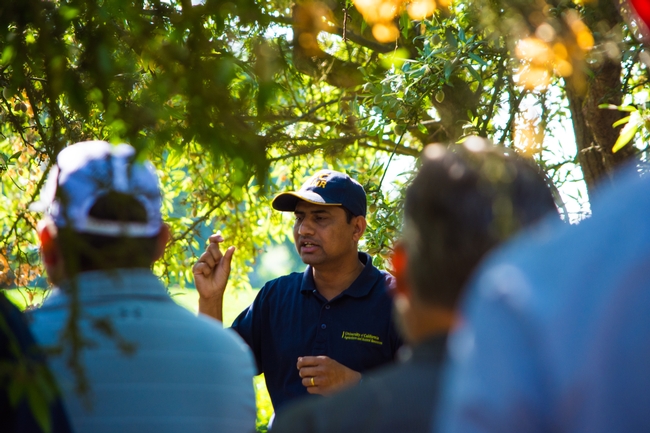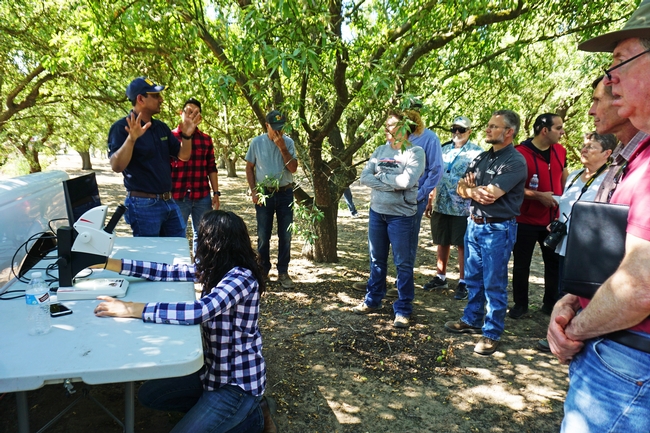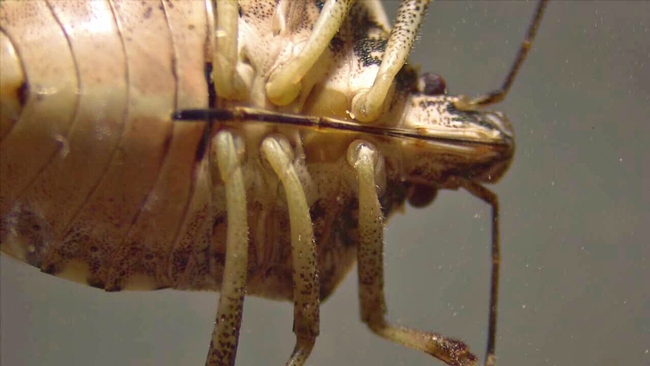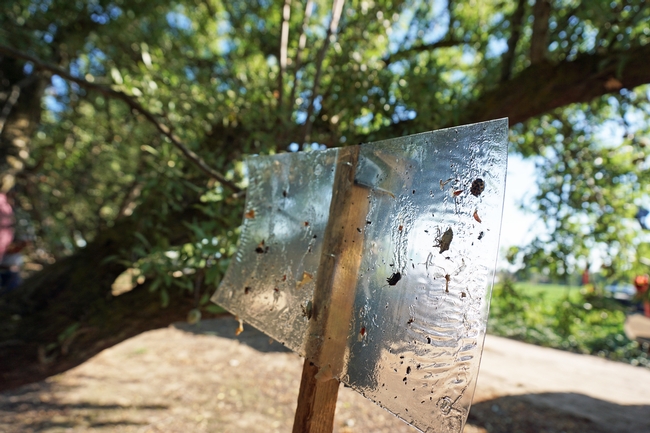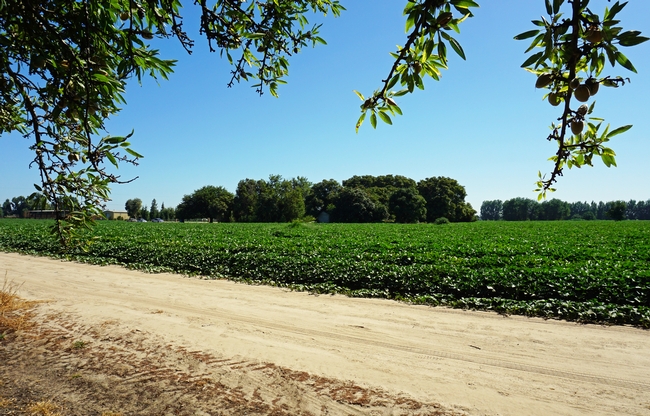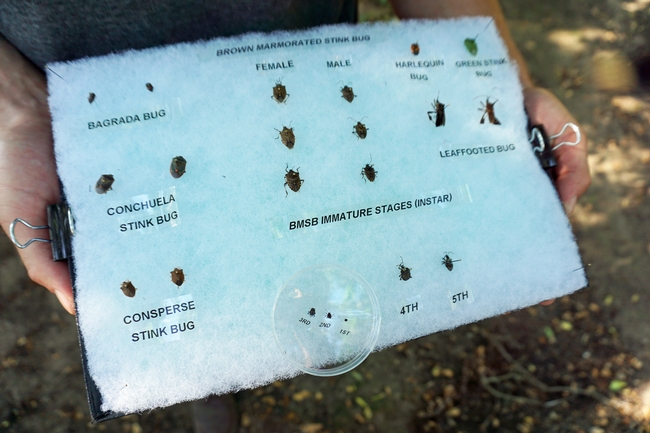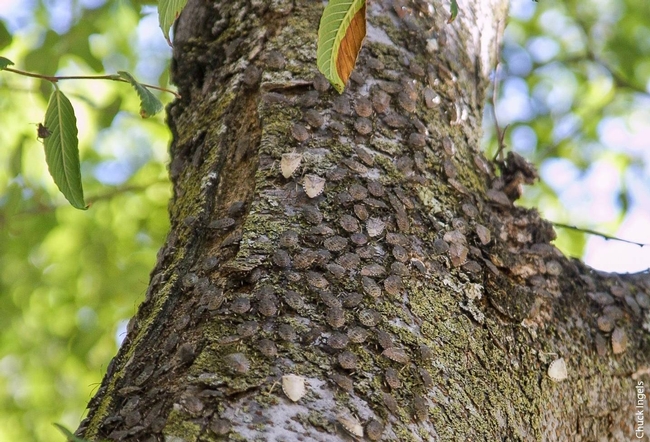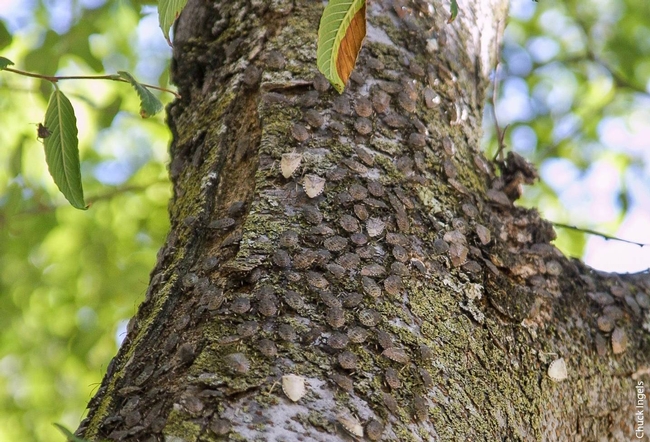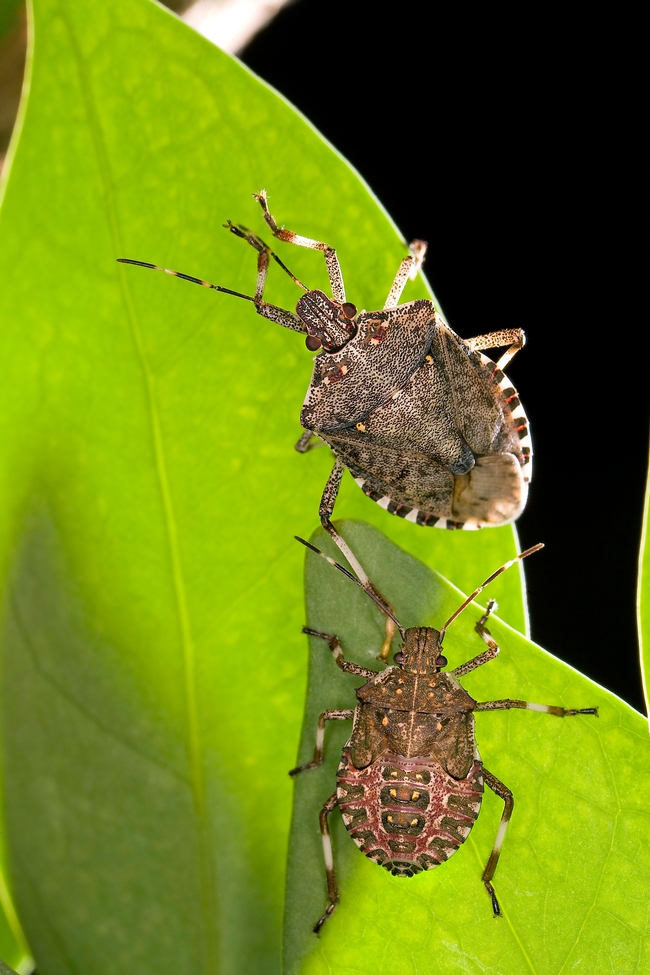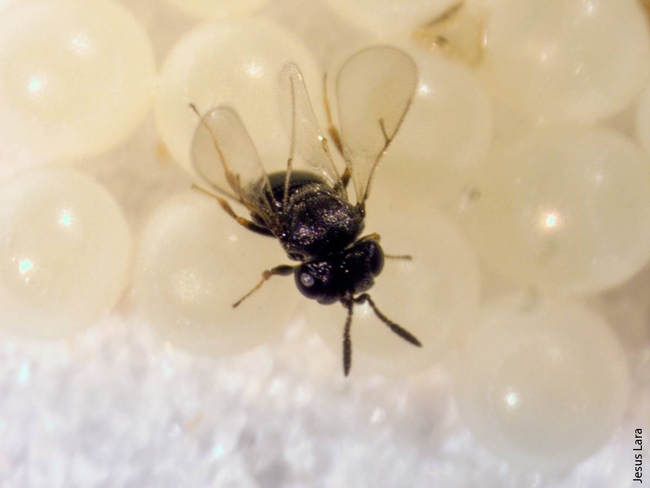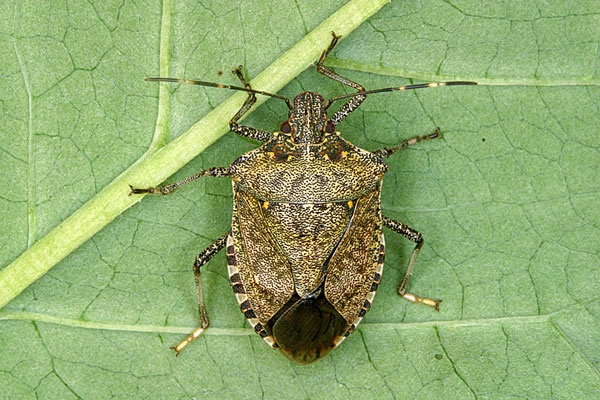Posts Tagged: stink bug
UCCE advisor addresses severe brown marmorated stink bug damage in Turlock orchard
Last May, a Turlock almond grower noticed nearly all the nuts on a row of trees in his orchard had fallen to the ground.
“It looked like we shook this row,” he said. “I was scared. I thought the whole orchard was going to go.”
He called UC Cooperative Extension.
UCCE Integrated Pest Management advisor Jhalendra Rijal, who serves Stanislaus, San Joaquin and Merced counties, determined the cause was an infestation of brown marmorated stink bug (BMSB), an invasive pest from Asia. For years, BMSB had only been found in urban areas of California – most notably a 2013 infestation in midtown Sacramento.
With few natural predators and a wide host range – including apples, pears, cherries, corn, tomatoes, grapes and a variety of landscape trees – the population eventually moved into agricultural areas, first appearing in crops in 2016 in Stanislaus County. Rijal has been doing BMSB research since then.
Rijal hosted a gathering of farmers and pest control advisers Aug. 13, 2019, in the Turlock almond orchard to give them a first-hand view of the pest and the problems it causes.
BMSB are hard to find in orchards. They lay greenish colored eggs on the underside of leaves, typically in a cluster of 28 eggs. The majority of damage is caused by adults, which sting the hull with a needle-like mouth part to get to the nut. The sting can even penetrate the almond's hard shell when the fruit is mature.
Globs of clear sticky sap appear on the damaged almond hulls, typically indicating nut loss inside. Early season (March-April) infestation leads to the most severe yield loss when the nuts drop to the ground. The best way to confirm the damage is caused by BMSB is to use a trap.
“I recommend growers and pest control advisors put BMSB traps in orchard edges if they suspect BMSB damage or if the orchard is located near potential overwintering structures or host crops,” Rijal said. “BMSB are good flyers and active throughout the season, damaging nuts from April through the fall. But the most substantial damage happens in the spring through early summer."
If the orchard is close to BMSB-favored host plants, more damage is seen. A particularly troublesome neighbor plant is tree-of-heaven.
“Tree-of-heaven is a magnet for BMSB,” Rijal said, pointing to an abandoned farmhouse site on an adjacent property. “Tree-of-heaven has a nice fruiting structure that can support a lot of BMSB.”
Also an Asia native, tree-of-heaven was brought to California by Chinese immigrants during the Gold Rush. The roots, leaves and bark are used in traditional Chinese medicine. But its rapid growth and ability to clone itself to develop thick groves make it a noxious weed.
BMSB isn't a serious pest in its homeland because it is controlled by a natural enemy. Charles Pickett, the California Department of Food and Agriculture biological control scientist, shared a mounted sample of a Samurai wasp from Asia, Trissolcas japonicus, which lays its eggs in BMSB eggs.
“The parasite attacks most of the eggs in the field in eastern Asia,” Pickett said. “It's our goal to release the wasp in California. We first need a special permit to make sure it won't harm our environment and doesn't attack any beneficial stink bugs.”
The Samurai wasp has already found its own way to some BMSB infestation sites in the Eastern U.S. and in Los Angeles.
“We hope to someday release the parasitic wasp,” Pickett said. “It won't eradicate BMSB, but it will help.”
Summer heat is suppressing brown marmorated stink bug
The sweltering summer of 2017 has a silver lining. When the temperature rises above 104, brown marmorated stink bug population growth is significantly slowed, reported Debbie Arrington in the Sacramento Bee.
An invasive pest from Asia, brown marmorated stink bugs showed up in midtown Sacramento in 2013. Their spread to commercial crops has been a concern. The stink bugs feed on dozens of California crops, including apples, pears, cherries, peaches, melons, corn, tomatoes, berries and grapes, said Chuck Ingels, UC Cooperative Extension advisor in Sacramento County. Feeding on fruit creates pock marks and distortions that make the fruit unmarketable. In grapes, berries collapse and rot increases.
In 2014 and 2015, the bugs' numbers continued to rise. In early 2016, Ingels feared a population explosion, but a heat wave in July, with seven days at 100 degrees or higher, plus two days at 104, wiped them out.
“This year, BMSB started off at historic lows (since 2013),” Ingels said. “Then, the June heat wave hit and the population that was there plummeted. Most of our trap counts for the last few weeks have been at or near zero, whereas there's usually a peak in June. So, it seems to be proof that temperatures over 100 for extended periods reduces the population – probably especially eggs and nymphs."
Ingels and UC Davis entomologists are studying the connection between high heat and stink bugs in the lab, where the pest is exposed to extreme temperatures. One hour at 113 degrees killed all the bugs, but mortality was also high over 104 degrees.
Please Eat a Stink Bug!
Oh, if we could just engage in some menu planning and preparation! How often have you thought of that after watching praying mantids dine on honey...

A praying mantis at the Bohart Museum of Entomology, UC Davis, dines on a stink bug. (Photo by Kathy Keatley Garvey)
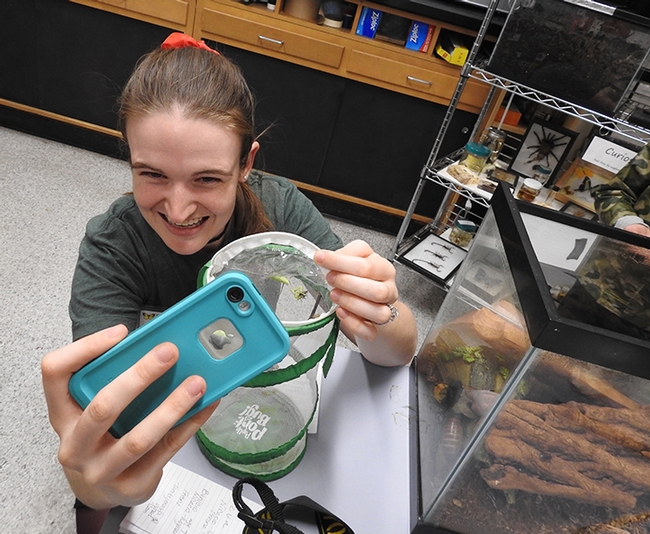
UC Davis entomology graduate student Charlotte Herbert, who is seeking her doctorate, takes a selfie with a praying mantis eating a stink bug. (Photo by Kathy Keatley Garvey)
UC and CDFA researchers make progress in fight against exotic brown marmorated stink bugs
Scientists are rearing tiny Asian wasps in quarantine and evaluating whether they can be released in California to battle brown marmorated stink bug (BMSB), an invasive pest that poses a serious threat to the state's $54 billion agricultural industry, they reported in the current issue of California Agriculture journal.
The wasp, Trissolcus japonicus, has scientists feeling hopeful, said Chuck Ingels, UC Cooperative Extension advisor in Sacramento County and one of the 10 authors of the article. Ingels and a team of UC and California Department of Food and Agriculture scientists have been closely monitoring BMSB since large populations were found in downtown Sacramento in 2013.
“We hope T. japonicus will render BMSB a much lower threat, to where it might end up a background stinkbug,” Ingels said. “It all depends on how well the parasitoid adapts to our climate if we get to the point of releasing it.”
At the moment, BMSB has not caused significant damage to agricultural crops in California, but UC scientists want to be ready with solutions should it migrate into farms. BMSB – a native of China, Korea, Japan and Taiwan – made its way to the East Coast of the U.S. in the 1990s. By 2010, it caused millions of dollars in crop damages in apples, peaches and vegetables. The pest was first detected in California in 2002. It is now in urban communities in Siskiyou, Butte, Sutter, Yolo, Sacramento, San Joaquin, Stanislaus, Santa Clara and Los Angeles counties.
In urban areas, the pest is a nuisance. Bugs aggregate in late summer on walls and trees, and then seek refuge in the winter inside homes, garages and other buildings. Massive aggregations of BMSB are a disturbing sight and emit a pungent cilantro-like odor. In restaurants, BMSB can alarm patrons when the insects are mistaken for cockroaches, potentially hurting the eatery's bottom line.
“Apartment managers complain that tenants are threatening to move out because of the stink bugs,” Ingels said. “It's an economic issue.”
But BMSB's potential for damage in commercial agricultural crops portends a much greater economic threat. BMSB's host plant range of 170 species includes many valuable fruit, nut, vegetable and ornamental crops. In August and September of 2015, BMSB was found feeding on citrus, persimmons and apples in a Sacramento community garden. In July 2015, BMSB was found for the first time in traps placed close to citrus, kiwi and avocados in Los Angeles County backyards.
Already, several “generalist predators” have been observed feeding on BMSB – such as lacewings, mantids, earwigs, lady beetles, assassin bugs, pirate bugs, big-eyed bugs and spiders. Field research has also found that at least 12 North American species of stink bug egg parasites will lay eggs in BMSB egg masses.
However, because the local species may not be enough to provide adequate levels of population suppression, the researchers are interested in T. japonicus, a natural enemy of BMSB in its home range in China. The wasp can help to control populations of BMSB by laying its own eggs inside BMSB eggs. The researchers say finding and establishing a host-specific natural enemy may significantly increase control and prevent further economic problems.
“The introduction of a beneficial natural enemy like T. japonicus, which co-evolved with BMSB in China, increases our chances of successfully targeting and suppressing BMSB populations in the United States,” said Ricky Lara, a post-doctoral scholar at UC Riverside and lead author of the article. “In California, UC and CDFA researchers will continue to conduct the required safety evaluations with T. japonicus to deliver a cost-effective BMSB biological control program.”
Without being introduced by authorities, T. japonicus have been found in Maryland, Virginia and Vancouver, Wash., presumably having been accidentally introduced via parasitized BMSB eggs from Asia. DNA analyses determined that the T. japonicus collected in the field did not originate from the populations in quarantine, indicating that there have been no accidental escapes from these secure facilities.
The California research was funded with a grant from the CDFA Specialty Crop Block Grant Program, which was awarded to Charles Pickett, CDFA senior environmental scientist specializing in biological control, and Mark Hoddle, UC Cooperative Extension biological control specialist. Funding was also provided by the USDA Farm Bill, the California Pistachio Research Board, the Pear Pest Management Research Fund and the Consolidated Central Valley Table Grape Pest and Disease Control District.
Invasive stink bugs found in Stanislaus County
The brown marmorated stink bug (BMSB) has made its way to Stanislaus County, reported John Holland in the Modesto Bee. The invasive pest, introduced into the U.S. from Asia, has also been detected in San Joaquin, Sacramento, Yolo, Sutter, Butte, Santa Clara and Los Angeles counties.
The stink bugs pose a threat to a wide variety of plants, including home-grown and commercial ornamentals, fruits, vegetables and nuts, said Jhalendra Rijal, the area integrated pest management advisor with UC Agriculture and Natural Resources. Rijal is based at the UC Cooperative Extension office in Modesto.
BMSB was found in two Stanislaus County locations in recent weeks: outside a business at Kansas Avenue and Highway 99 in Modesto and outside the home of a pest control adviser in Turlock. Rijal said there have been no reports of BMSB in the county's farmland, but they could be out there.
"There is definitely potential for this pest, because it can feed on many host plants in agricultural and urban settings," he said.
The Modesto Bee quoted the UC IPM Pest Note on brown marmorated stink bug in its article.
"An efficient way to collect stink bugs indoors is by sucking them up with a dry or wet vacuum," the Pest Note says. "The bugs will cause the collection canister or bag and other parts of the vacuum to give off an unpleasant stink bug odor, so some people dedicate a vacuum cleaner to stink bug capture only."
The pest note provides detailed information on monitoring for and managing stink bug infestations.


